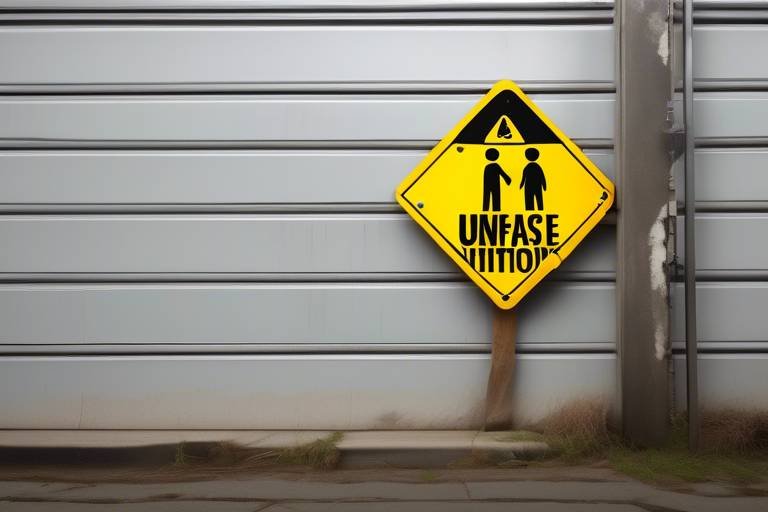Verbal Self-Defense - Essential Safety Skill
In today's fast-paced world, the ability to communicate effectively is more than just a social skill; it’s a vital form of self-defense. Verbal self-defense equips individuals with the tools to navigate potentially dangerous situations using words rather than fists. Imagine being in a heated confrontation where tensions are high and emotions are running wild. Wouldn't it be empowering to know how to steer the conversation away from conflict and towards resolution? This article dives deep into the art of verbal self-defense, exploring techniques, strategies, and real-life applications that can empower you in confrontational situations.
Verbal self-defense isn’t just about protecting yourself from physical harm; it’s about safeguarding your mental and emotional well-being. It’s the ability to stand your ground, express your feelings, and assert your needs without resorting to aggression. Think of it as a mental shield that protects you from the verbal blows that can come from others. By mastering this skill, you not only enhance your personal safety but also improve your overall communication skills, making you a more confident and assertive individual.
As we progress through this article, you’ll discover how verbal self-defense differs from physical self-defense and why it’s equally, if not more, important. We’ll explore key techniques for effective communication, such as assertiveness, active listening, and maintaining a calm demeanor. These skills are essential for navigating tense interactions and can be the difference between escalating a situation and resolving it peacefully.
Moreover, we’ll delve into recognizing verbal aggression and identifying common triggers that lead to confrontations. Understanding these elements can help you anticipate potential threats and respond appropriately. With the right tools at your disposal, you’ll find that you can defuse even the most volatile situations with grace and poise.
So buckle up as we embark on this journey of empowerment through verbal self-defense. Whether you’re looking to enhance your personal safety, improve your communication skills, or simply gain more confidence in your interactions, this article is here to guide you every step of the way. Let’s get started!
- What is verbal self-defense?
Verbal self-defense is the use of communication techniques to prevent or de-escalate confrontational situations, protecting oneself from verbal aggression and enhancing personal safety. - How does verbal self-defense differ from physical self-defense?
While physical self-defense involves protecting oneself from physical harm, verbal self-defense focuses on using language and communication to navigate and defuse potentially dangerous interactions. - Can anyone learn verbal self-defense?
Yes! Verbal self-defense techniques can be learned and practiced by anyone, regardless of their background or experience in conflict resolution. - Why is active listening important in verbal self-defense?
Active listening allows you to truly understand the other person's perspective, which can help reduce conflict and create a more constructive dialogue. - What are some common triggers of verbal aggression?
Common triggers include misunderstandings, stress, and personal insecurities. Recognizing these can help you navigate and de-escalate confrontations effectively.

Understanding Verbal Self-Defense
Verbal self-defense is a powerful skill that often goes unnoticed in discussions about personal safety. While many people think of self-defense as something physical—like martial arts or self-defense classes—verbal self-defense is equally crucial. It involves using language and communication techniques to navigate and defuse potentially dangerous situations. Imagine walking into a bar and sensing tension in the air; instead of resorting to physical confrontation, you can use your words as your shield. This is the essence of verbal self-defense.
What makes verbal self-defense so significant? For starters, it empowers individuals to take control of their interactions without resorting to violence. In a world where conflicts can escalate quickly, having the ability to communicate effectively can mean the difference between a heated argument and a peaceful resolution. Unlike physical self-defense, which often requires training and practice, verbal self-defense can be learned and applied by anyone. It’s about being aware of your surroundings, understanding the dynamics of communication, and using that knowledge to protect yourself.
Verbal self-defense differs from physical self-defense in several key ways. While physical self-defense focuses on reacting to a threat with physical force, verbal self-defense is proactive. It’s about anticipating potential conflicts and using your voice to steer conversations away from confrontation. This approach not only protects you but also fosters a more respectful and understanding environment. Think of it as the difference between a firefighter and a smoke detector; both are essential for safety, but one actively prevents disaster while the other reacts to it.
In essence, verbal self-defense is not merely about what you say but how you say it. It encompasses a range of techniques, including assertiveness, active listening, and maintaining a calm demeanor. By mastering these skills, you can effectively navigate tense interactions and reduce the likelihood of escalation. So, as we delve deeper into the techniques and strategies of verbal self-defense, remember that your words are your most powerful tool. Use them wisely!

Key Techniques for Effective Communication
Effective communication is the backbone of verbal self-defense. It’s not just about what you say, but how you say it. Imagine you're in a heated discussion, and instead of escalating the situation, you manage to steer the conversation towards a peaceful resolution. This is the power of communication techniques that can transform confrontations into constructive dialogues. In this section, we'll dive into essential techniques such as assertiveness, active listening, and maintaining a calm demeanor that can help you navigate tense interactions.
First off, let's talk about assertiveness. This is all about expressing your thoughts and feelings in a way that is confident yet respectful. It’s like standing your ground without building a wall. When you're assertive, you communicate your needs clearly and directly, which can prevent misunderstandings and reduce the likelihood of conflict. Instead of saying, “You never listen to me,” try, “I feel unheard when you interrupt me.” This slight shift in phrasing not only conveys your feelings but also invites a more productive conversation.
Now, assertiveness training is key. It’s not just about being bold; it’s about being clear and respectful. When you practice assertiveness, you’re not just stating your needs; you're also fostering an environment of mutual respect. Think of it as setting the stage for a dialogue where both parties can express themselves without fear of judgment or retaliation. Here are a couple of tips to enhance your assertiveness:
- Use clear and direct language: Avoid vague statements that can lead to misinterpretations.
- Practice saying no: It’s okay to decline requests that make you uncomfortable.
Setting personal boundaries is another vital aspect of effective communication. Boundaries are like invisible lines that protect your emotional space. When you communicate your boundaries clearly, you’re not only protecting yourself but also helping others understand how to interact with you. For instance, if you feel overwhelmed by constant interruptions during meetings, it’s perfectly acceptable to say, “I need everyone to allow me to finish my thoughts before responding.” This not only clarifies your needs but also encourages a more respectful dialogue.
Another powerful tool in your communication arsenal is the use of I statements. These statements allow you to express your feelings without placing blame on others. Instead of saying, “You make me feel anxious,” you can say, “I feel anxious when discussions get heated.” This technique helps in minimizing defensiveness from others, making it easier for them to hear you without feeling attacked. It’s a subtle shift, but it can make a world of difference in how your message is received.
Next up is active listening. This is more than just hearing what someone says; it’s about truly understanding their message. When you practice active listening, you show the other person that you value their perspective. This can be achieved through techniques like nodding, maintaining eye contact, and paraphrasing what they’ve said to confirm your understanding. For example, you might say, “So what I’m hearing is that you feel frustrated with the current project timeline.” This not only clarifies the message but also demonstrates your willingness to engage in a meaningful dialogue.
By incorporating these techniques into your daily interactions, you can significantly enhance your ability to communicate effectively. Whether you’re dealing with a friend, colleague, or even a stranger, these skills empower you to navigate potentially volatile situations with confidence and grace. Remember, the goal is to foster understanding and respect, turning confrontational moments into opportunities for connection.
Q: What is verbal self-defense?
A: Verbal self-defense involves using communication techniques to defuse tense or potentially dangerous situations without resorting to physical confrontation.
Q: How can I practice assertiveness?
A: You can practice assertiveness by clearly expressing your needs, using “I statements,” and setting boundaries in a respectful manner.
Q: What are some signs of verbal aggression?
A: Signs of verbal aggression include yelling, insults, sarcasm, and hostile body language. Recognizing these signs can help you respond appropriately.
Q: How can I improve my active listening skills?
A: You can improve your active listening skills by maintaining eye contact, nodding in agreement, and summarizing what the speaker has said to ensure understanding.

Assertiveness Training
Assertiveness training is an essential aspect of verbal self-defense that empowers individuals to express their needs and desires confidently, without resorting to aggression. It’s like learning to navigate a ship through stormy seas; you need to know how to steer your vessel without capsizing. Assertiveness isn't about being bossy or domineering; rather, it's about communicating your thoughts and feelings clearly while respecting the rights of others. This balance is crucial for maintaining healthy relationships and ensuring personal safety.
When you practice assertiveness, you’re essentially setting the stage for a respectful dialogue. Imagine walking into a room filled with tension; your assertive demeanor can act as a calming presence. You might wonder, “How do I become more assertive?” The answer lies in understanding that assertiveness is a skill that can be developed through practice. Here are some key components of assertiveness training:
- Clear Communication: Use straightforward language to express your thoughts. Avoid vague statements that can lead to misunderstandings.
- Body Language: Your non-verbal cues should match your words. Maintain eye contact and use open gestures to convey confidence.
- Practice Saying No: It’s okay to decline requests that infringe on your boundaries. Saying no is a powerful form of self-advocacy.
One effective method to enhance your assertiveness is through role-playing scenarios. By practicing real-life situations with a friend or in a safe environment, you can build confidence and refine your responses. For example, if someone interrupts you during a conversation, practice responding with a calm, “I’d like to finish my thought before we move on.” This approach not only reinforces your point but also encourages others to respect your speaking time.
Additionally, using I statements can significantly improve your assertiveness. Instead of saying, “You never listen to me,” try rephrasing it to, “I feel unheard when I’m interrupted.” This subtle shift focuses on your feelings rather than placing blame, which can help to reduce defensiveness from the other person. Remember, the goal is to foster a dialogue, not a confrontation.
In summary, assertiveness training is not just about speaking up; it’s about creating an environment where communication thrives. By incorporating these techniques into your daily interactions, you’ll discover that you can stand your ground while still being respectful and open to others. Just like a skilled musician who can play both loudly and softly, mastering assertiveness allows you to navigate complex social situations with grace and confidence.

Setting Boundaries
Setting boundaries is not just a personal preference; it's a crucial aspect of verbal self-defense that empowers you to maintain your personal space and emotional well-being. Imagine you're at a gathering, and someone crosses the line with an inappropriate comment. Instead of letting it slide, you can assertively communicate your discomfort. This is where the magic of boundaries comes into play. By clearly stating what is acceptable and what isn't, you not only protect yourself but also foster a culture of respect around you.
When setting boundaries, clarity is key. You want to express your limits in a way that is direct yet respectful. For instance, if a colleague frequently interrupts you during meetings, you might say, “I appreciate your enthusiasm, but I would like to finish my thoughts before we discuss.” This approach not only asserts your boundaries but also encourages a more respectful dialogue. Remember, boundaries are not walls; they are guidelines that help people understand how to interact with you.
Here are some essential tips for effectively communicating your boundaries:
- Be Clear and Specific: Instead of vague statements, specify what actions are unacceptable. For example, instead of saying “I don’t like that,” you could say, “I feel uncomfortable when you raise your voice at me.”
- Use "I" Statements: Frame your feelings using "I" statements to express your needs without sounding accusatory. For example, “I need some time to myself right now” is more effective than “You’re always bothering me.”
- Stay Calm and Composed: When asserting boundaries, maintain a calm demeanor. This not only helps you stay in control but also encourages the other person to respond positively.
Setting boundaries isn't just about saying "no"; it's about creating an environment where you feel safe and respected. It's essential to remember that not everyone will react positively to your boundaries. Some may push back or test your limits. This is where your confidence comes into play. Stand firm in your decisions and remind yourself that your feelings and needs are valid. By doing so, you not only protect yourself but also model healthy communication for others.
In conclusion, setting boundaries is an essential skill in verbal self-defense. It allows you to communicate your needs clearly and assertively while fostering mutual respect in your interactions. Remember, it's perfectly okay to prioritize your comfort and well-being. After all, everyone deserves to feel safe and respected in their personal and professional lives.
- What are boundaries? Boundaries are personal guidelines that define what you are comfortable with in various situations. They help protect your emotional and physical space.
- Why is setting boundaries important? Setting boundaries is crucial for maintaining healthy relationships and personal safety. It ensures that others understand your limits and respect your needs.
- How do I start setting boundaries? Begin by identifying your needs and feelings. Practice expressing them clearly and assertively in your conversations.
- What if someone disrespects my boundaries? If someone crosses your boundaries, calmly reiterate your limits. If they continue to disrespect them, consider distancing yourself from that person.

Using
This article explores the concept of verbal self-defense, emphasizing its importance in personal safety and communication. It covers techniques, strategies, and real-life applications to empower individuals in confrontational situations.
Verbal self-defense involves using language and communication techniques to defuse potentially dangerous situations. It's not just about what you say, but how you say it. This section explains its significance and how it differs from physical self-defense. While physical self-defense may involve striking or grappling, verbal self-defense focuses on the power of words. It’s about **empowering** yourself with the right phrases and tones to navigate through conflicts smoothly.
Effective communication is crucial in verbal self-defense. Here, we discuss essential techniques such as assertiveness, active listening, and maintaining a calm demeanor to navigate tense interactions. These skills can help you stay composed and articulate, even when faced with aggression.
Assertiveness is a core component of verbal self-defense. It’s about standing your ground without being aggressive. This subsection outlines how to express needs confidently without aggression, fostering respect and clarity in communication. Think of assertiveness as your personal shield; it protects you from being overwhelmed by others while allowing you to express yourself clearly and firmly.
Establishing personal boundaries is vital for safety. This section provides tips on how to communicate boundaries clearly and effectively to prevent escalation in confrontational situations. Setting boundaries is like drawing a line in the sand—once it's established, it becomes easier to maintain respect in conversations. Here are some effective ways to set boundaries:
- Be clear and specific about your limits.
- Use “I” statements to express your feelings.
- Stay calm and composed when stating your boundaries.
'I' statements help express feelings without blaming others. This part explains how to use this technique to convey emotions and needs while minimizing defensiveness from others. For example, instead of saying, “You always interrupt me,” you might say, “I feel overlooked when I’m interrupted.” This subtle shift in language reduces the likelihood of the other person becoming defensive, fostering a more productive dialogue. Here’s how to effectively use 'I' statements:
- Start with “I feel” to express your emotions.
- Follow with the behavior that is affecting you.
- End with a request for change or understanding.
Incorporating 'I' statements into your communication toolkit can significantly enhance your ability to express yourself without escalating tensions. Remember, it’s about sharing your feelings rather than pointing fingers!
Active listening enhances understanding and reduces conflict. This subsection covers techniques for truly hearing others, fostering a more positive dialogue in potentially volatile situations. It’s not just about hearing words; it’s about understanding the emotions behind them. When you actively listen, you’re not only showing respect but also creating an environment where the other person feels valued.
Identifying verbal aggression is crucial for effective self-defense. This section discusses common signs of aggressive communication and how to respond appropriately to mitigate threats. Recognizing the signs early can be your first line of defense.
Understanding triggers can help in anticipating and de-escalating confrontations. This part highlights typical scenarios that lead to verbal aggression and how to navigate them safely. Common triggers can include:
- Stressful environments
- Miscommunication or misunderstandings
- Personal attacks or insults
Effective de-escalation techniques can diffuse tense situations. This subsection outlines strategies for calming aggressive individuals and shifting the conversation towards a more constructive direction. Techniques such as maintaining a calm tone, using open body language, and acknowledging the other person's feelings can significantly help in reducing hostility.
Q: What is verbal self-defense?
A: Verbal self-defense is the use of communication techniques to protect oneself from verbal aggression and to defuse potentially dangerous situations.
Q: How do 'I' statements help in communication?
A: 'I' statements allow you to express your feelings without blaming others, which helps to reduce defensiveness and promotes a more open dialogue.
Q: Can verbal self-defense be learned?
A: Absolutely! With practice and awareness, anyone can learn effective verbal self-defense techniques and improve their communication skills.
Q: What are some signs of verbal aggression?
A: Signs include yelling, insults, sarcasm, and dismissive body language. Recognizing these can help you respond appropriately.

I
This article explores the concept of verbal self-defense, emphasizing its importance in personal safety and communication. It covers techniques, strategies, and real-life applications to empower individuals in confrontational situations.
Verbal self-defense involves using language and communication techniques to defuse potentially dangerous situations. This section explains its significance and how it differs from physical self-defense.
Effective communication is crucial in verbal self-defense. Here, we discuss essential techniques such as assertiveness, active listening, and maintaining a calm demeanor to navigate tense interactions.
Assertiveness is a core component of verbal self-defense. This subsection outlines how to express needs confidently without aggression, fostering respect and clarity in communication.
Establishing personal boundaries is vital for safety. This section provides tips on how to communicate boundaries clearly and effectively to prevent escalation in confrontational situations.
statements help express feelings without blaming others. This technique is incredibly useful in maintaining a constructive dialogue during conflicts. By framing your emotions in terms of your own experiences, you can convey your needs without provoking defensiveness in others. For instance, instead of saying, “You never listen to me,” you might say, “I feel overlooked when my thoughts aren’t acknowledged.” This subtle shift not only highlights your feelings but also encourages the other person to engage without feeling attacked.
Using statements effectively requires practice. Here are some key elements to consider:
- Be specific: Clearly state what behavior is affecting you.
- Express your feelings: Share how that behavior makes you feel.
- Communicate your needs: Let the other person know what you would like to happen moving forward.
Through this approach, you create an environment where the other person is more likely to listen and respond positively. Remember, the goal is to foster understanding and connection, rather than to escalate the situation.
Active listening enhances understanding and reduces conflict. This subsection covers techniques for truly hearing others, fostering a more positive dialogue in potentially volatile situations.
Identifying verbal aggression is crucial for effective self-defense. This section discusses common signs of aggressive communication and how to respond appropriately to mitigate threats.
Understanding triggers can help in anticipating and de-escalating confrontations. This part highlights typical scenarios that lead to verbal aggression and how to navigate them safely.
Effective de-escalation techniques can diffuse tense situations. This subsection outlines strategies for calming aggressive individuals and shifting the conversation towards a more constructive direction.
What is verbal self-defense? Verbal self-defense is the use of communication techniques to prevent or defuse conflict without physical confrontation.
How can I improve my assertiveness? Practice expressing your thoughts and feelings in a clear and respectful manner. Role-playing can also help build confidence.
What are some signs of verbal aggression? Signs include yelling, insults, sarcasm, and hostile body language. Recognizing these can help you respond appropriately.
Can verbal self-defense be learned? Absolutely! With practice and awareness, anyone can learn effective verbal self-defense techniques.

Statements
This article explores the concept of verbal self-defense, emphasizing its importance in personal safety and communication. It covers techniques, strategies, and real-life applications to empower individuals in confrontational situations.
Verbal self-defense involves using language and communication techniques to defuse potentially dangerous situations. This section explains its significance and how it differs from physical self-defense.
Effective communication is crucial in verbal self-defense. Here, we discuss essential techniques such as assertiveness, active listening, and maintaining a calm demeanor to navigate tense interactions.
Assertiveness is a core component of verbal self-defense. This subsection outlines how to express needs confidently without aggression, fostering respect and clarity in communication.
Establishing personal boundaries is vital for safety. This section provides tips on how to communicate boundaries clearly and effectively to prevent escalation in confrontational situations.
I statements are a powerful tool in verbal self-defense, allowing individuals to express their feelings and needs without casting blame on others. When you use I statements, you're taking ownership of your emotions, which can significantly reduce defensiveness in the other person. For example, instead of saying, “You never listen to me,” you might say, “I feel unheard when I’m interrupted.” This shift in language not only communicates your feelings but also opens the door for a more constructive dialogue.
To effectively use I statements, consider the following structure:
- I feel [emotion] when [situation].
- I need [what you need].
- I would appreciate [desired outcome].
For instance, if a colleague frequently interrupts you during meetings, instead of confronting them aggressively, you could say, “I feel frustrated when I’m interrupted. I need the opportunity to finish my thoughts. I would appreciate it if you could let me complete my points before responding.” This approach not only communicates your needs but also encourages a respectful exchange of ideas.
Using I statements can transform a potentially hostile interaction into a more empathetic conversation. By focusing on your feelings and needs rather than accusing the other person, you’re less likely to provoke defensiveness and more likely to foster understanding. It’s a subtle yet powerful shift that can lead to more effective communication and conflict resolution.
Active listening enhances understanding and reduces conflict. This subsection covers techniques for truly hearing others, fostering a more positive dialogue in potentially volatile situations.
Identifying verbal aggression is crucial for effective self-defense. This section discusses common signs of aggressive communication and how to respond appropriately to mitigate threats.
Understanding triggers can help in anticipating and de-escalating confrontations. This part highlights typical scenarios that lead to verbal aggression and how to navigate them safely.
Effective de-escalation techniques can diffuse tense situations. This subsection outlines strategies for calming aggressive individuals and shifting the conversation towards a more constructive direction.
Q: What is verbal self-defense?
A: Verbal self-defense is the use of communication techniques to protect oneself from verbal aggression and to defuse potentially dangerous situations.
Q: How do I practice assertiveness?
A: You can practice assertiveness by expressing your needs clearly and respectfully, using I statements, and setting boundaries in your interactions.
Q: What are some signs of verbal aggression?
A: Signs of verbal aggression include shouting, name-calling, sarcasm, and dismissive body language. Recognizing these signs can help you respond effectively.
Q: Can verbal self-defense be learned?
A: Yes! Like any skill, verbal self-defense can be learned and improved with practice. Techniques such as active listening and assertiveness training can be very beneficial.

I
This article explores the concept of verbal self-defense, emphasizing its importance in personal safety and communication. It covers techniques, strategies, and real-life applications to empower individuals in confrontational situations.
Verbal self-defense involves using language and communication techniques to defuse potentially dangerous situations. It is an essential skill that can be the difference between escalating a conflict and resolving it peacefully. Unlike physical self-defense, which focuses on bodily protection, verbal self-defense empowers individuals to navigate confrontations using their words and tone. This approach not only safeguards personal safety but also promotes healthier communication patterns.
Effective communication is crucial in verbal self-defense. To successfully navigate tense interactions, one must master a variety of techniques. These include assertiveness, active listening, and maintaining a calm demeanor. By honing these skills, individuals can become more adept at managing confrontational situations, often leading to positive outcomes without resorting to aggression.
Assertiveness is a core component of verbal self-defense. It involves expressing your needs and feelings confidently without coming off as aggressive. Imagine walking into a room filled with tension; your ability to assert yourself can shift the atmosphere entirely. By practicing assertive communication, you foster respect and clarity, making it easier for others to understand your perspective. This is not just about speaking up; it's about doing so in a way that promotes dialogue rather than discord.
Establishing personal boundaries is vital for safety. Clear communication of your limits can prevent escalation in confrontational situations. For instance, if someone is invading your personal space or speaking to you disrespectfully, calmly stating, "I need you to step back," can effectively create distance and signal that their behavior is unacceptable. Remember, boundaries are not just about saying 'no'; they are about maintaining your comfort and safety in interactions.
statements help express feelings without blaming others. This technique is incredibly effective in communicating emotions and needs while minimizing defensiveness from others. For example, instead of saying, "You never listen to me," try rephrasing it as, "I feel unheard when you interrupt me." This subtle shift not only conveys your feelings but also invites a more constructive response from the other person. By focusing on your experience rather than placing blame, you create an environment conducive to understanding and resolution.
Active listening enhances understanding and reduces conflict. It’s not just about hearing words; it’s about truly engaging with what the other person is saying. Techniques for active listening include maintaining eye contact, nodding to show understanding, and repeating back what you’ve heard to confirm comprehension. This practice fosters a more positive dialogue, especially in potentially volatile situations. When people feel heard, they are less likely to escalate their aggression, making it a powerful tool in verbal self-defense.
Identifying verbal aggression is crucial for effective self-defense. Understanding the common signs of aggressive communication can prepare you to respond appropriately and mitigate threats. This awareness allows you to navigate potentially dangerous situations with greater confidence and control.
Understanding triggers can help in anticipating and de-escalating confrontations. Typical scenarios that lead to verbal aggression can include misunderstandings, personal insults, or even stressful environments. By recognizing these triggers, you can develop strategies to navigate them safely. For instance, if you notice someone becoming increasingly agitated, you might choose to change the subject or suggest a break to cool down tensions.
Effective de-escalation techniques can diffuse tense situations. Strategies such as maintaining a calm voice, using humor appropriately, and showing empathy can shift the conversation towards a more constructive direction. For example, acknowledging the other person's feelings by saying, "I can see this is really important to you," can help lower defenses and open up a pathway for dialogue rather than confrontation.
- What is verbal self-defense?
Verbal self-defense is a technique that uses communication skills to defuse potentially dangerous situations.
- How does verbal self-defense differ from physical self-defense?
While physical self-defense focuses on bodily protection, verbal self-defense emphasizes the use of language and communication to manage conflicts.
- Can verbal self-defense be learned?
Yes, verbal self-defense can be learned through practice and training in communication techniques.
- What are some common techniques for verbal self-defense?
Key techniques include assertiveness, active listening, and the use of statements.

statements help express feelings without blaming others. This part explains how to use this technique to convey emotions and needs while minimizing defensiveness from others.
When it comes to expressing our feelings, many of us often slip into the habit of pointing fingers or placing blame on others. This can lead to defensiveness and heightened tension in conversations. Instead, utilizing I statements can be a game-changer. So, what exactly are I statements? Simply put, they are a way to communicate your feelings and needs without making the other person feel attacked. For instance, instead of saying, “You never listen to me,” you might express, “I feel unheard when I’m interrupted.” This subtle shift in language can significantly alter the dynamics of a conversation.
Using I statements effectively involves a few key components. First, you start with I feel, followed by an emotion, and then explain the situation that triggered that feeling. This structure not only clarifies your emotions but also helps the other person understand your perspective without feeling cornered. Here’s a quick breakdown:
| Component | Example |
|---|---|
| I feel | I feel anxious |
| Emotion | when deadlines are tight |
| Situation | because I want to ensure quality work. |
By using this format, you are not only expressing your feelings but also providing context that can lead to a more productive dialogue. It’s like holding up a mirror to your emotions, allowing others to see and understand your perspective without feeling attacked. This technique can be particularly effective in heated discussions, where tempers might flare and misunderstandings can escalate.
Another significant advantage of I statements is that they promote accountability. When you express your feelings using this technique, you take ownership of your emotions rather than shifting the blame onto someone else. This can foster a sense of mutual respect and understanding, paving the way for more open and honest conversations. Think of it as planting a seed of empathy; when you share your feelings without blame, you encourage the other person to respond in kind.
However, it’s essential to practice this technique consistently. Just like any skill, mastering I statements takes time and effort. Start small—try incorporating them into everyday conversations. You might be surprised at how quickly you notice a positive shift in your interactions. Additionally, be mindful of your tone and body language; these non-verbal cues can significantly impact how your message is received. Remember, the goal here is to create a safe space for dialogue, not to ignite further conflict.
In conclusion, using I statements is a powerful tool in the realm of verbal self-defense. By expressing your feelings without blaming others, you not only communicate more effectively but also minimize defensiveness, allowing for a more constructive conversation. So the next time you find yourself in a potentially heated discussion, take a moment to reflect on how you can frame your thoughts using I statements. It’s a simple yet effective way to enhance your communication skills and foster healthier relationships.
- What are I statements? I statements are a way to express your feelings and needs without blaming others, helping to reduce defensiveness in conversations.
- How do I use I statements effectively? Start with "I feel," followed by your emotion and the situation that triggered it. For example, "I feel upset when my opinions are dismissed."
- Can I statements help in all situations? While they are beneficial in many scenarios, it's essential to consider the context and the relationship dynamics when using them.
- What if the other person reacts negatively? Stay calm and reiterate your feelings using I statements. It may take time for the other person to process the information.

Active Listening Skills
Active listening is more than just hearing words; it’s about fully engaging with the speaker and understanding their message. Imagine you’re at a coffee shop, and someone is sharing a personal story. Instead of zoning out or thinking about your response, you lean in, maintain eye contact, and nod occasionally to show you’re present. This level of engagement not only makes the speaker feel valued but also helps you grasp the nuances of what they’re saying. It's like tuning into a radio station; if you’re not properly tuned in, you’ll miss the important details.
In the realm of verbal self-defense, active listening can be a game-changer. It allows you to identify underlying emotions and intentions, which can help you navigate potentially explosive situations. When someone is upset, they might not articulate their feelings clearly. By practicing active listening, you can pick up on cues—like tone of voice and body language—that reveal what’s truly going on. This skill is essential, as it can prevent misunderstandings and reduce the likelihood of conflict.
To enhance your active listening skills, consider the following techniques:
- Maintain Eye Contact: This shows the speaker that you are engaged and interested in what they have to say.
- Reflect Back: Paraphrase what the speaker has said to confirm your understanding. For example, “So what you’re saying is…” This not only clarifies but also demonstrates that you’re paying attention.
- Avoid Interrupting: Let the speaker finish their thoughts before you respond. Interrupting can come off as dismissive and may escalate tensions.
- Ask Open-Ended Questions: Encourage the speaker to elaborate by asking questions that cannot be answered with a simple ‘yes’ or ‘no.’ This fosters deeper dialogue and shows that you care about their perspective.
Incorporating these techniques into your daily interactions can significantly improve your communication skills. Just think about a time when someone really listened to you; it likely made you feel heard and understood. Now, imagine being that person for someone else. Not only will it enhance your relationships, but it can also serve as a powerful tool in de-escalating conflicts. When the other person feels acknowledged, they are more likely to lower their defenses and engage in a constructive conversation.
Ultimately, active listening is an invaluable skill that can empower you in various aspects of life. Whether you’re in a heated discussion or simply trying to connect with someone on a deeper level, being an active listener can transform the way you communicate. It’s not just about hearing words; it’s about understanding the feelings and intentions behind those words. So, the next time you find yourself in a tense situation, remember that your ability to listen actively could be the key to turning things around.
What is active listening?
Active listening is a communication technique that involves fully concentrating, understanding, responding, and remembering what is being said. It goes beyond just hearing words and requires engagement with the speaker.
How can active listening help in verbal self-defense?
By practicing active listening, you can better understand the emotions and intentions behind someone’s words, which can help you navigate confrontations more effectively and reduce the likelihood of escalation.
What are some signs of effective active listening?
Effective active listening includes maintaining eye contact, reflecting back what the speaker has said, avoiding interruptions, and asking open-ended questions to encourage further dialogue.
Can active listening be learned?
Absolutely! Active listening is a skill that can be developed with practice. By consciously applying the techniques of active listening in your daily conversations, you can become more proficient over time.

Recognizing Verbal Aggression
Verbal aggression can be likened to a sudden storm; it often appears out of nowhere, leaving chaos in its wake. Recognizing the signs of verbal aggression is essential for anyone looking to protect themselves and navigate potentially dangerous situations. Verbal aggression isn’t just about shouting or using harsh words; it can manifest in subtler forms, making it crucial to stay vigilant. Understanding these signs can help you respond effectively, ensuring your safety and well-being.
Common indicators of verbal aggression include:
- Raised Voices: A significant increase in volume often signals that a person is losing control of their emotions.
- Hostile Language: Words that are derogatory or belittling can indicate an aggressive intent.
- Body Language: Non-verbal cues, such as clenched fists, aggressive posturing, or invading personal space, can amplify the verbal aggression being expressed.
- Interruptions: Constantly cutting you off or talking over you is a clear sign of disrespect and aggression.
Recognizing these signs can be the first step in de-escalating a potentially harmful situation. When you identify that the other person is becoming aggressive, it’s important to remain calm and composed. Your ability to maintain a steady demeanor can often diffuse the tension in the air. Think of it as being the eye of the storm; while chaos swirls around you, staying centered can help you regain control of the conversation.
Another important aspect of recognizing verbal aggression is understanding the common triggers that lead to such behavior. These triggers can vary from individual to individual, but some frequent scenarios include:
- Stressful situations, such as deadlines or high-pressure environments.
- Miscommunication or misunderstandings that escalate due to lack of clarity.
- Personal issues that the aggressor may be experiencing, which can manifest as frustration directed at others.
By being aware of these triggers, you can better anticipate when a conversation might go south and take proactive measures to steer it back on course. For instance, if you sense that a colleague is becoming agitated due to a looming deadline, addressing their concerns with empathy can help defuse their frustration before it escalates.
In addition to recognizing the signs and triggers of verbal aggression, it’s crucial to develop a strategy for responding. This is where your verbal self-defense skills come into play. By practicing techniques such as active listening, assertiveness, and maintaining a calm demeanor, you can effectively manage confrontations. Remember, the goal is not to escalate the situation further but to find a resolution that respects both parties involved.
In summary, recognizing verbal aggression is a vital skill that can help you navigate confrontational situations. By understanding the signs, being aware of common triggers, and employing effective communication strategies, you can empower yourself to handle aggression with confidence. Just like a seasoned sailor navigating rough seas, your ability to read the waves of communication can keep you safe and in control.
Q: What should I do if someone is being verbally aggressive towards me?
A: Stay calm and composed. Use assertive communication to set boundaries and try to de-escalate the situation by actively listening and acknowledging their feelings.
Q: How can I practice verbal self-defense techniques?
A: Role-playing with a friend or practicing in front of a mirror can help you become more comfortable with assertiveness and active listening skills.
Q: Is verbal aggression always dangerous?
A: While verbal aggression can escalate to physical confrontation, it’s not always dangerous. Recognizing it early can help you manage the situation before it intensifies.
Q: Can verbal self-defense techniques be applied in everyday life?
A: Absolutely! These techniques are valuable in various situations, from workplace conflicts to personal relationships, helping you communicate more effectively and assertively.

Common Triggers of Aggression
Understanding the is essential for anyone looking to enhance their verbal self-defense skills. Just like a volcano waiting to erupt, people often have underlying frustrations that, when provoked, can lead to explosive reactions. Identifying these triggers allows you to navigate conversations more safely and effectively. Some of the most frequent triggers include:
- Stressful Situations: High-pressure environments, whether at work or home, can create a volatile mix. When people feel overwhelmed, their patience wears thin, making them more susceptible to aggressive outbursts.
- Personal Attacks: Insults or perceived slights can ignite a defensive reaction. When someone feels personally attacked, their instinct may be to retaliate verbally.
- Disrespect: A lack of respect in communication, whether through tone, body language, or word choice, can trigger aggression. It’s like throwing gasoline on a fire; it only intensifies the situation.
- Miscommunication: Misunderstandings are a breeding ground for conflict. When messages are unclear, individuals may fill in the gaps with their assumptions, leading to unnecessary confrontations.
- Substance Influence: Alcohol and drugs can impair judgment and lower inhibitions, making individuals more likely to react aggressively in situations they might otherwise handle calmly.
Recognizing these triggers is only half the battle. The real challenge lies in how to respond when you encounter them. For example, if you notice someone is stressed, you might approach the conversation more gently or choose a different time to discuss sensitive topics. This proactive approach is akin to navigating a minefield; the more you understand the terrain, the safer your journey will be.
Moreover, it’s crucial to remember that aggression often stems from a place of fear or insecurity. When you can empathize with the other person’s feelings, you open the door to a more constructive dialogue. Instead of escalating the situation, you can work towards de-escalation by acknowledging their feelings and steering the conversation in a more positive direction.
In conclusion, understanding the common triggers of aggression not only empowers you to protect yourself verbally but also enhances your ability to communicate effectively. By being aware of these triggers and adjusting your approach, you can create a safer environment for yourself and others, transforming potential conflicts into opportunities for growth and understanding.
Q: What are some signs that someone is becoming aggressive?
A: Look for changes in body language, such as clenched fists, an intense stare, or a raised voice. These can be indicators that a person is feeling threatened or frustrated.
Q: How can I de-escalate a situation if I notice someone becoming aggressive?
A: Use a calm tone, maintain open body language, and acknowledge their feelings. Avoid arguing or raising your voice, as this can further escalate the situation.
Q: Are there specific words or phrases I should avoid when communicating with someone who seems aggressive?
A: Yes, avoid using accusatory language or phrases that could be interpreted as dismissive. Instead, focus on using "I" statements to express your feelings without placing blame.

De-escalation Techniques
In the heat of a confrontation, emotions can run high, and tensions can escalate quickly. This is where come into play, acting as a safety net to help defuse potentially volatile situations. Imagine walking a tightrope; one wrong move, and you could fall into chaos. However, with the right strategies, you can maintain your balance and guide the interaction toward a more peaceful resolution.
One effective de-escalation technique is to maintain a calm demeanor. When faced with aggression, your body language and tone of voice can either fuel the fire or extinguish it. By speaking softly and clearly, you can create an atmosphere of calm that encourages the other person to mirror your behavior. It’s like tossing a pebble into a pond; the ripples of your calmness can spread outward, influencing the emotional state of those around you.
Another crucial strategy is to acknowledge the other person's feelings. Often, people just want to be heard. By validating their emotions, you can reduce their defensiveness and open the door for constructive dialogue. For instance, you might say, “I can see that you’re upset, and I want to understand what you’re feeling.” This approach shows empathy and can help lower the tension in the room.
Additionally, it's important to ask open-ended questions. These questions encourage the other person to express themselves without feeling cornered. Instead of saying, “Why are you so angry?” which can sound accusatory, try asking, “What’s been bothering you?” This simple shift in language can transform the interaction from confrontational to collaborative, allowing both parties to work towards a solution.
Here’s a quick table summarizing some effective de-escalation techniques:
| Technique | Description |
|---|---|
| Maintain Calmness | Use a soft tone and relaxed body language to create a peaceful environment. |
| Acknowledge Feelings | Validate the other person's emotions to reduce defensiveness. |
| Ask Open-Ended Questions | Encourage dialogue by prompting the other person to share their thoughts. |
| Use Empathy | Show understanding and relate to their feelings to build rapport. |
Lastly, remember that sometimes, walking away is the best option. If the situation becomes too heated and you feel that words alone won’t suffice, it’s perfectly okay to excuse yourself. This isn’t a sign of weakness; rather, it’s a strategic retreat that can prevent escalation and allow you to regroup. Think of it as a chess game; sometimes the best move is to pull back and reassess your strategy before re-engaging.
By mastering these de-escalation techniques, you equip yourself with the tools necessary to navigate confrontational situations effectively. It’s not just about protecting yourself; it’s about fostering a culture of respect and understanding in your interactions. Remember, every conversation is an opportunity to connect, and with the right approach, even the most challenging discussions can lead to positive outcomes.
- What is verbal self-defense? Verbal self-defense involves using communication techniques to defuse potentially dangerous situations without resorting to physical confrontation.
- How can I practice de-escalation techniques? Start by role-playing scenarios with friends or family, focusing on maintaining calmness, acknowledging feelings, and asking open-ended questions.
- When should I walk away from a confrontation? If the situation escalates beyond verbal communication and you feel unsafe, it’s best to excuse yourself and seek a safer environment.
- Can de-escalation techniques be used in everyday conversations? Absolutely! These techniques can enhance all types of interactions, helping to build better relationships and understanding.
Frequently Asked Questions
- What is verbal self-defense?
Verbal self-defense is a set of communication techniques designed to defuse potentially dangerous situations through the power of words. Unlike physical self-defense, it focuses on using language to assert boundaries, express needs, and prevent conflicts from escalating.
- How does verbal self-defense differ from physical self-defense?
While physical self-defense involves defensive maneuvers to protect oneself from physical harm, verbal self-defense aims to manage and de-escalate confrontations using communication skills. It’s about staying safe through dialogue rather than physical confrontation.
- What are some key techniques for effective verbal self-defense?
Key techniques include assertiveness, active listening, and maintaining a calm demeanor. These skills help you communicate clearly and confidently, making it easier to navigate tense situations without escalating conflict.
- How can I practice assertiveness?
Practicing assertiveness involves expressing your needs and feelings confidently while respecting others. You can start by using "I" statements, setting clear boundaries, and practicing saying no when necessary. This builds your confidence in communicating effectively.
- What are "I" statements and how do they help?
"I" statements are a communication tool that allows you to express your feelings and thoughts without blaming others. For example, saying "I feel upset when..." instead of "You make me upset..." can reduce defensiveness and foster a more constructive conversation.
- How can I improve my active listening skills?
Improving active listening skills involves fully focusing on the speaker, showing empathy, and providing feedback. Techniques like nodding, summarizing what the other person said, and asking clarifying questions can enhance understanding and reduce misunderstandings.
- What are the signs of verbal aggression?
Common signs of verbal aggression include yelling, insults, sarcasm, and hostile body language. Recognizing these signs early can help you respond appropriately and take steps to de-escalate the situation before it spirals out of control.
- How can I de-escalate a tense situation?
De-escalation techniques include staying calm, using a soft tone of voice, acknowledging the other person's feelings, and redirecting the conversation. By focusing on finding common ground and showing empathy, you can help diffuse tensions and move towards a resolution.



















